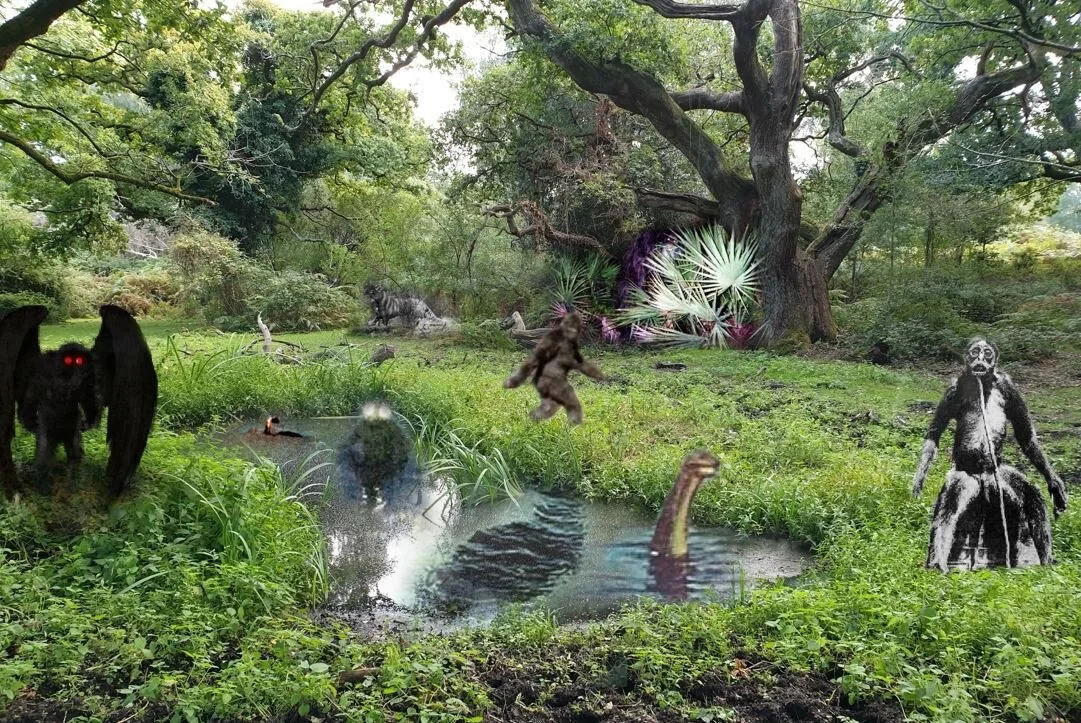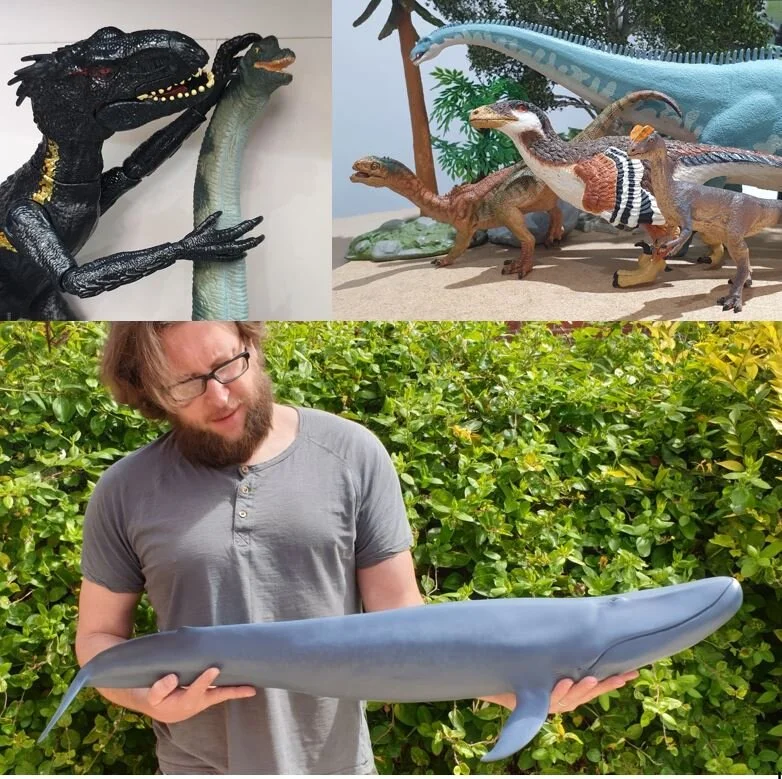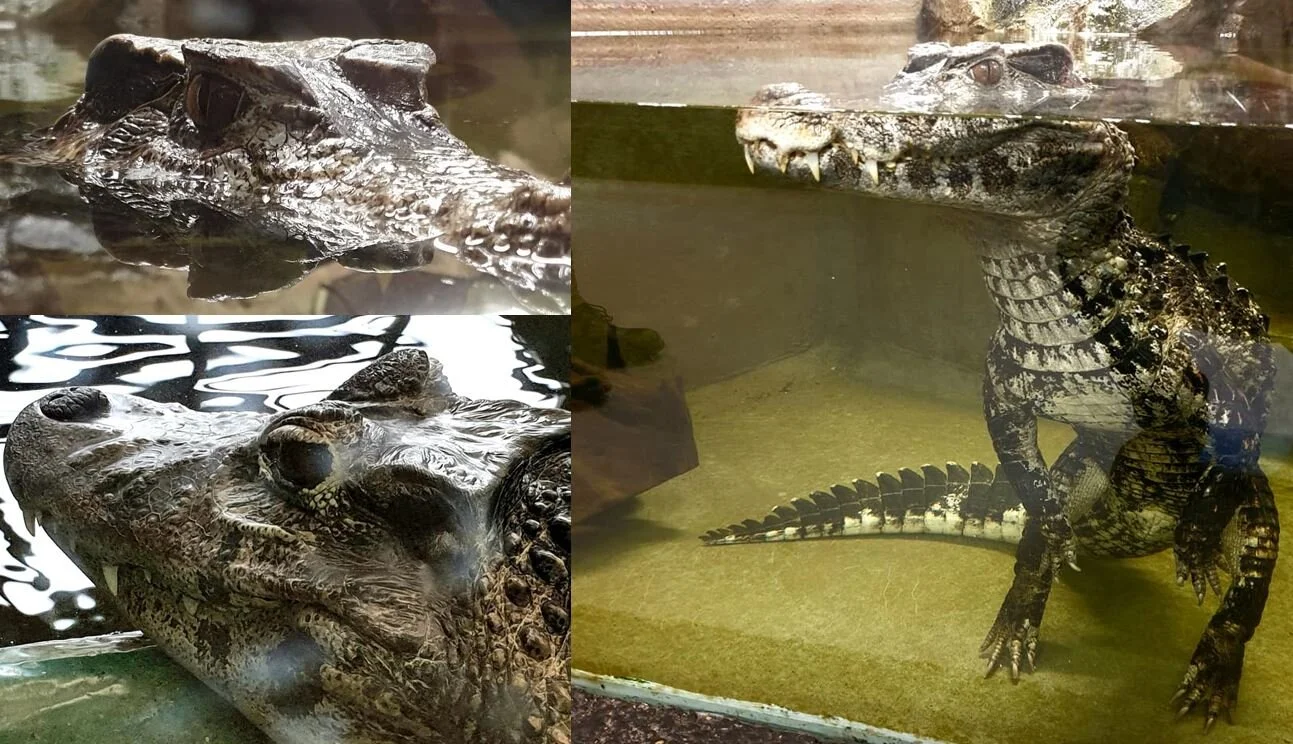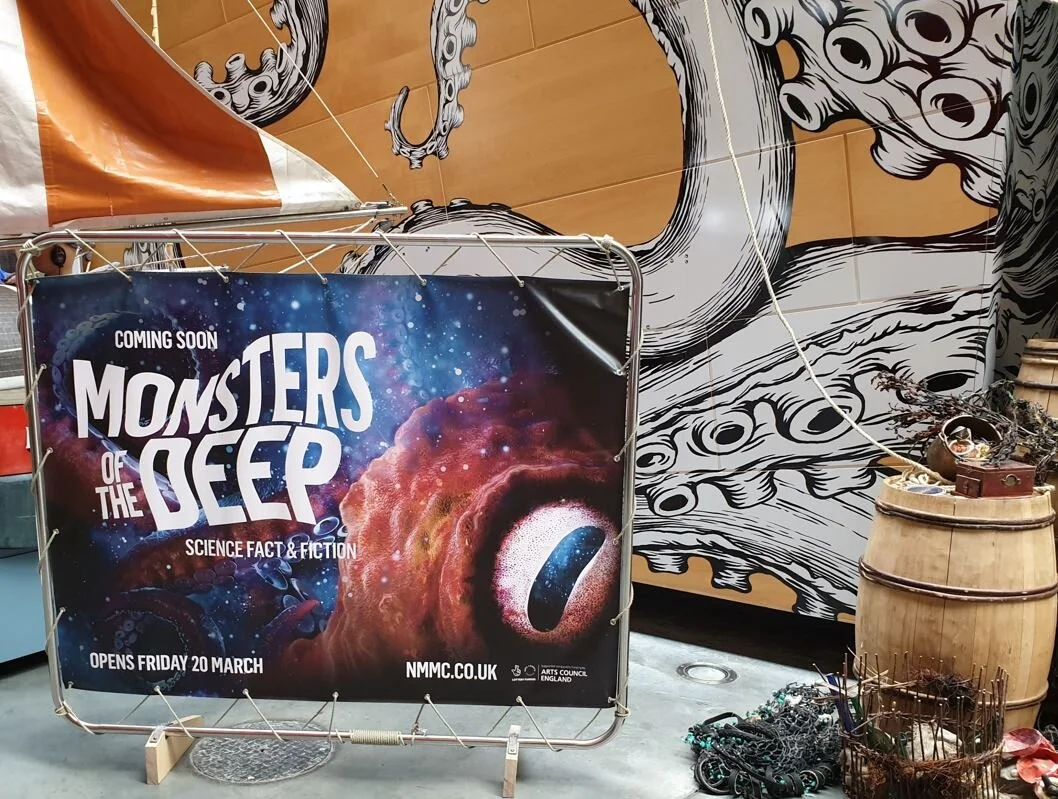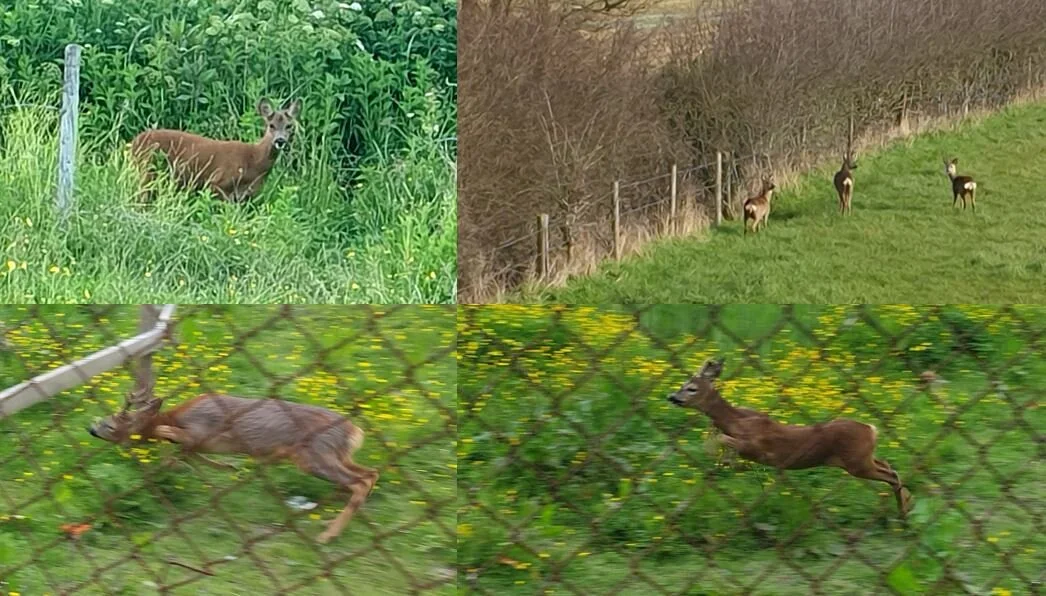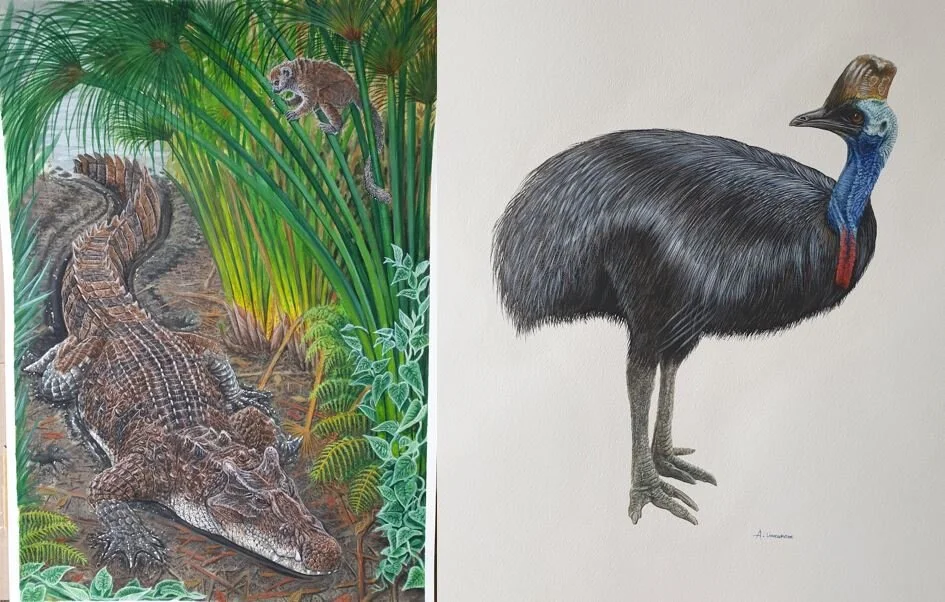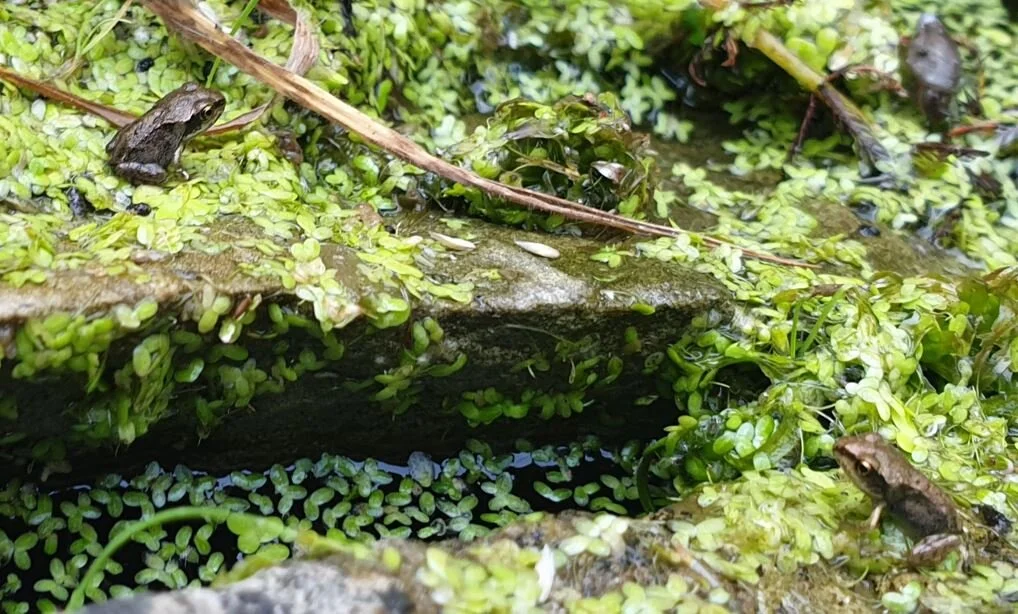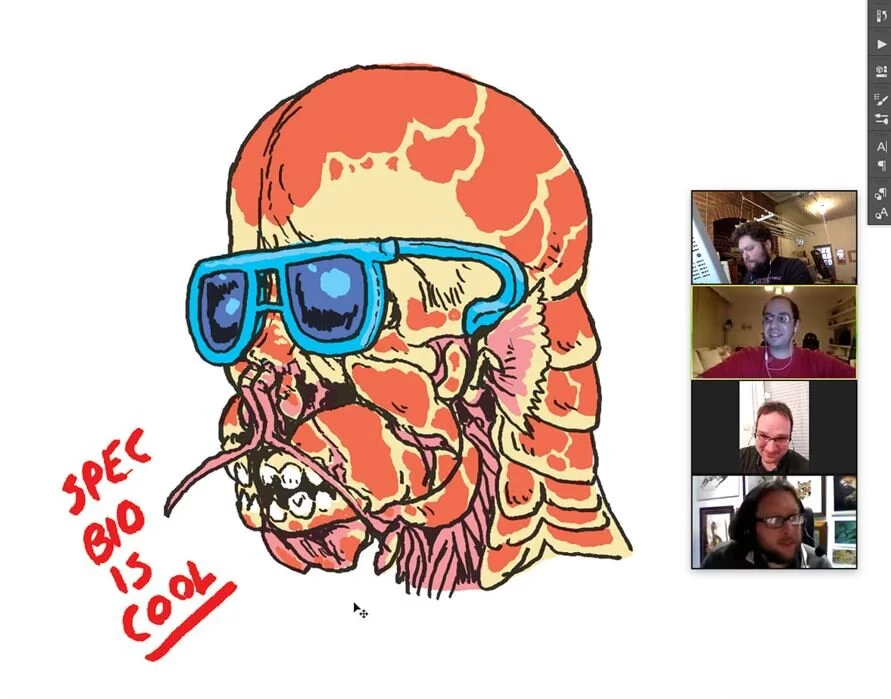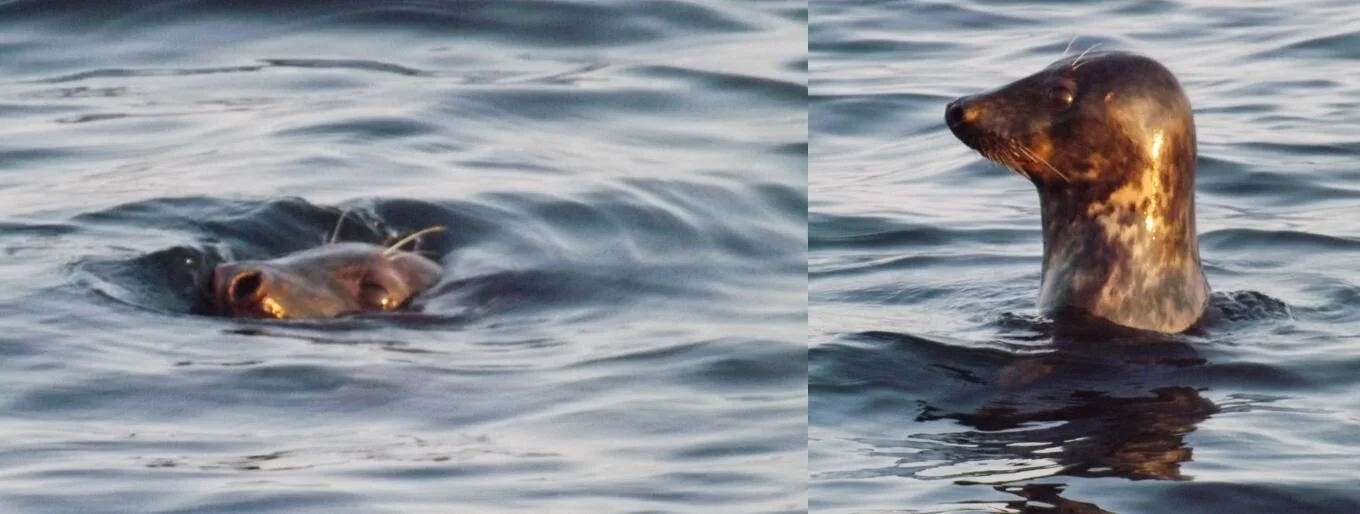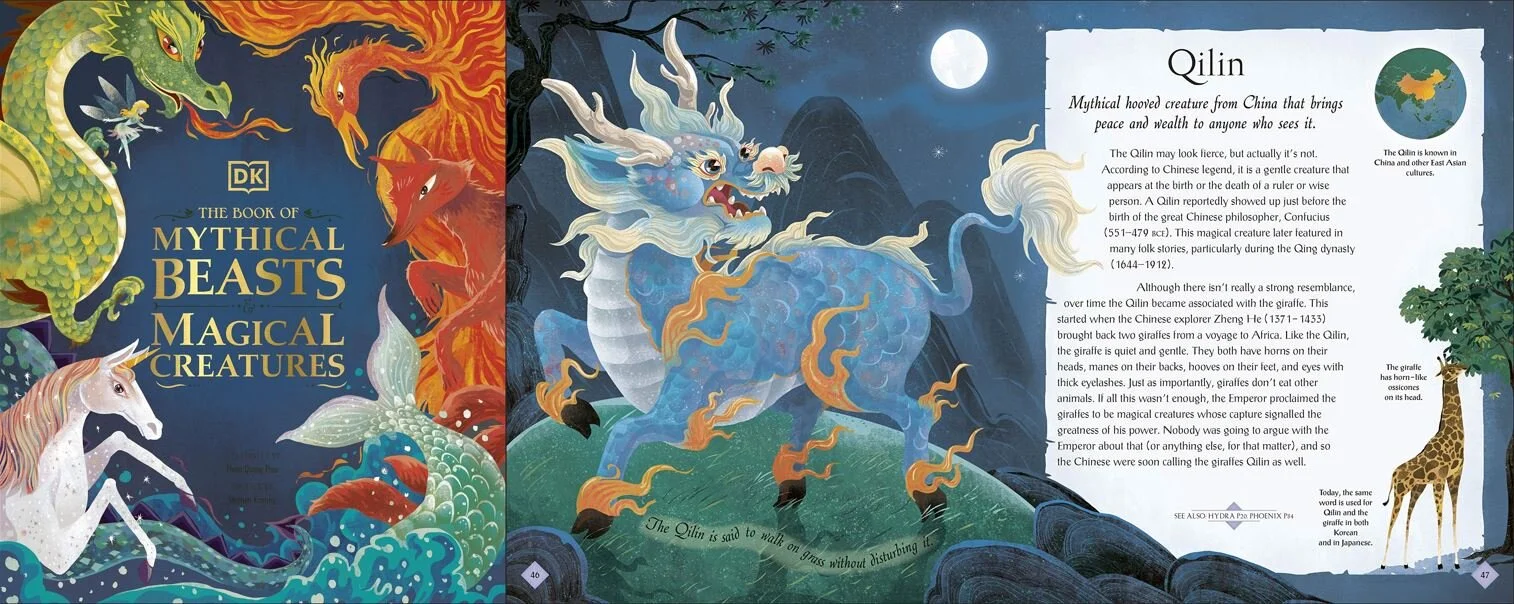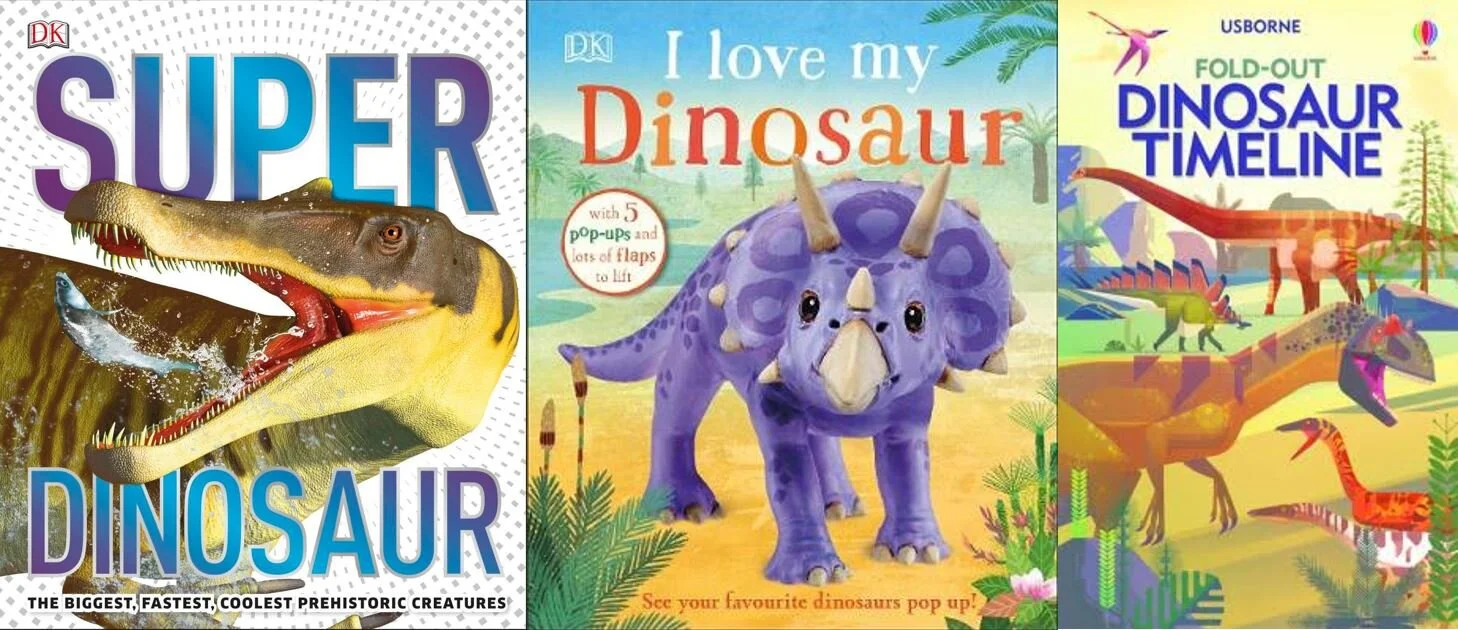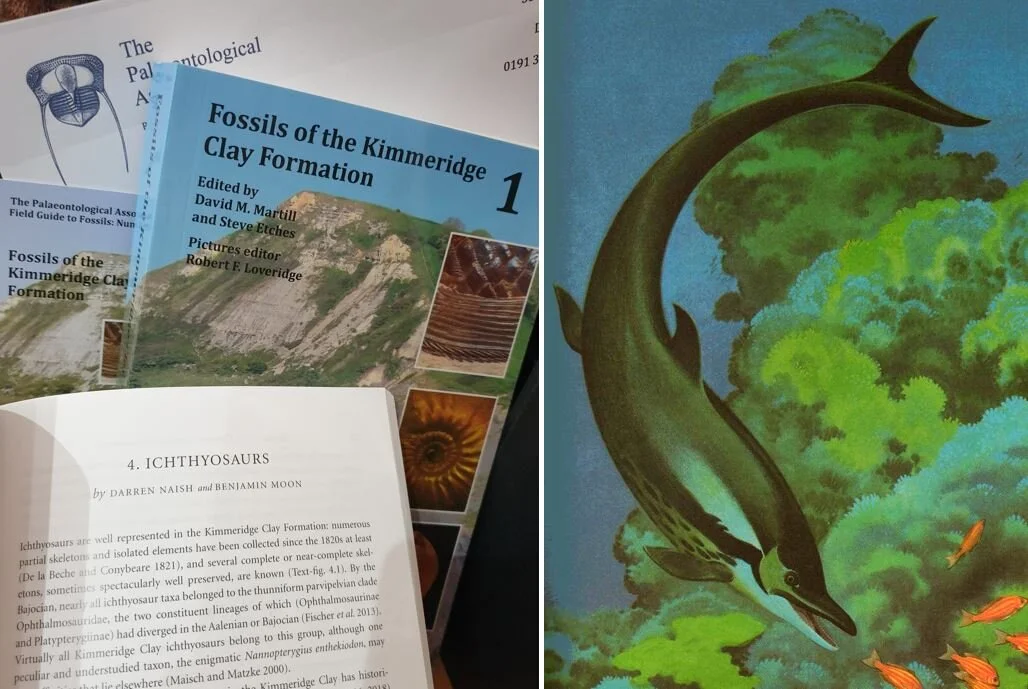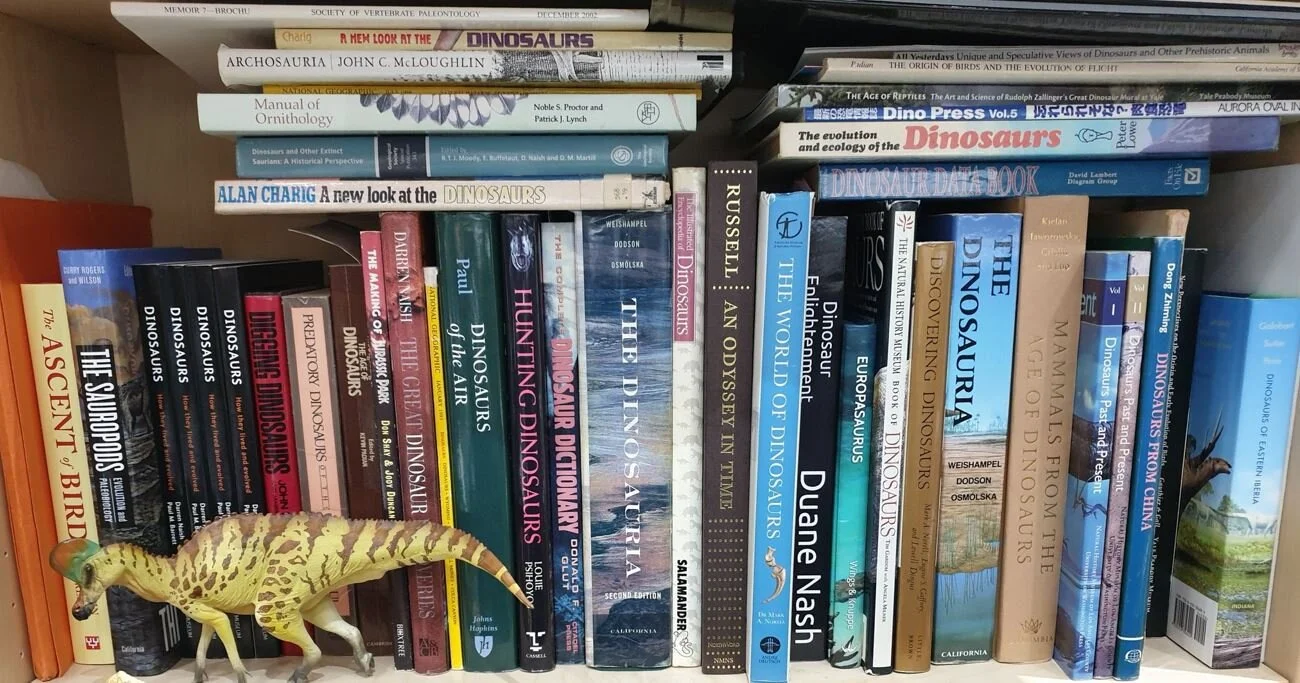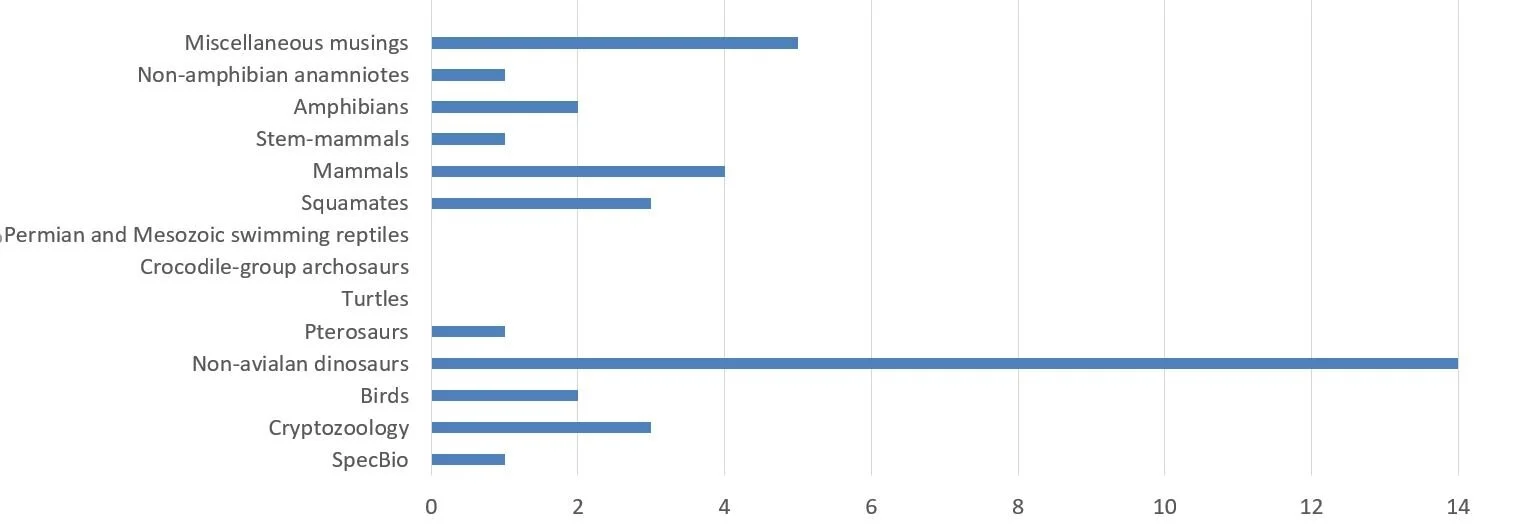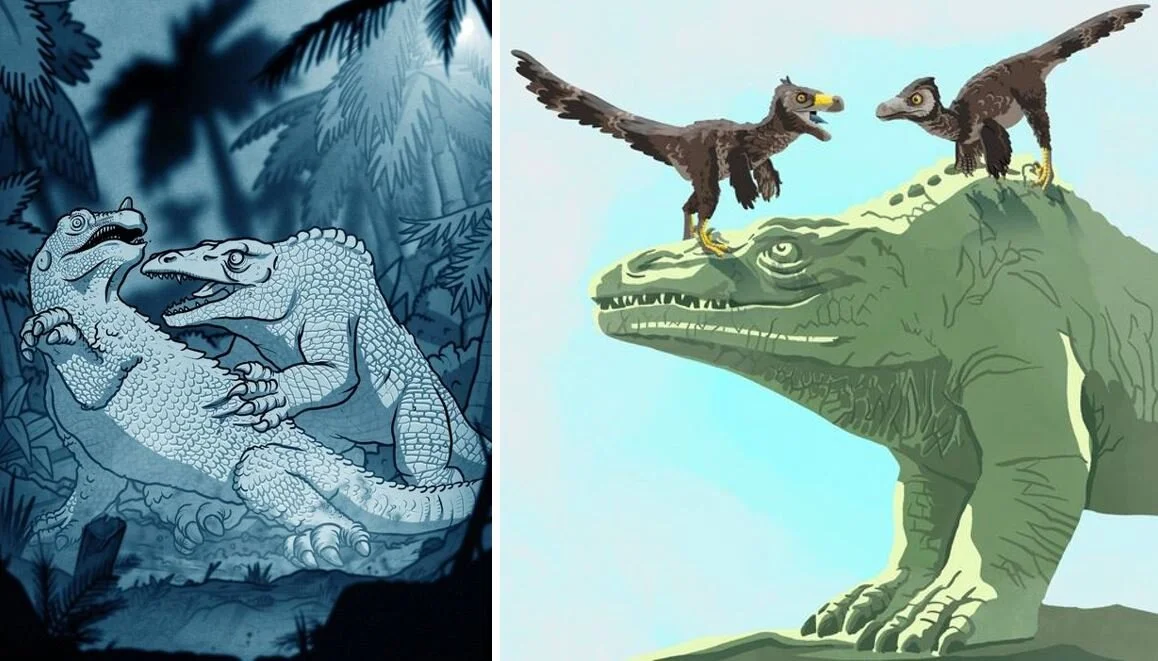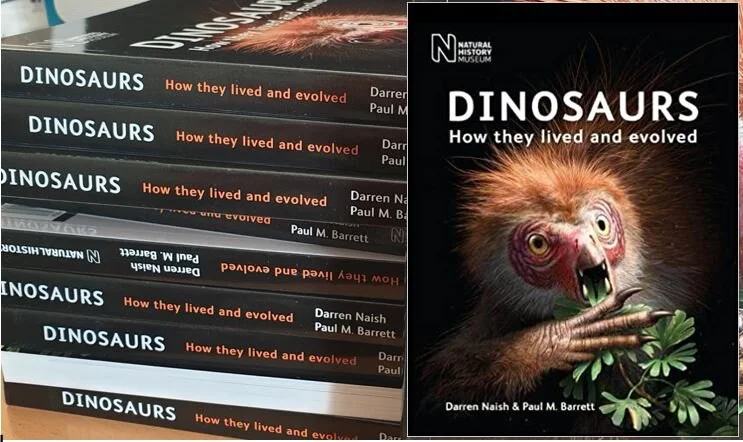Yes, it’s true — on January 21st 2021, the blog Tetrapod Zoology marked its 15th birthday…
Caption: a New Forest scene from September 2020…. albeit slightly augmented by the good work of Alexander Vieira. Lots of references here to material that’s appeared at TetZoo, on which read on…
2020 was the strangest year, one that many of us regard as a year somehow ‘lost’. A year when we failed to see the people we normally get to see, failed to visit the places we wanted to, and failed to get out and about and attend the events, meetings and gatherings that are normally a part of life. A consequence of those things is that TetZoo’s year of operation – that is, the year between Jan 21st 2020 and Jan 21st 2021 – was a quiet one, in ways, but also a stupidly busy one in others. Yes, January 21st is Tetrapod Zoology’s birthday – it’s the date on which I started this endeavour 15 years ago – meaning that it’s once more time to look back at the year that’s passed. Happy birthday, Tetrapod Zoology, 15 years old as of Jan’ 21st.
Caption: 2020 being what it was, I had a fair bit of opportunity to mess around with assorted animal models and toys…
As per usual, I’ll begin with the disclaimer that this article is extremely self-absorbed and self-referential, as is normal for these birthday articles. Stop reading now if you don’t want to hear me discussing my own adventures and escapades.
Swimming giraffes, zoos, and lizards. We start with the events of late January 2020, during which time I was partly based in Bristol due to work on a TV project which I still can’t yet discuss. Freelancing and research meant commuting between Southampton, Bristol and London, and such were the ties with Bristol that – early in the year – we (as in, my family and I) opted to move house. But things didn’t go to plan on that... During February, I visited Oxford and did the museums with the family, and the middle of the month saw the TV quiz show QI feature the swimming giraffe research published by myself and Don Henderson back in 2010 (Henderson & Naish 2010). Finally, some mainstream recognition… (kidding; our swimming giraffe research was covered to death in the popular media back when it was first published. See the article here).
Caption: Henderson & Naish (2010) is discussed on QI, what an accolate. Image: (c) BBC.
At TetZoo, the latest in my incredibly slow-burn series on the zoos of the world – this one devoted to the Isle of Wight Zoo at Sandown – was published. Damn, I really need to get a move on and publish more parts of that series. Also at TetZoo during February, I reviewed a number of recently(ish) published dinosaur-themed books, and wrote about the African lacertid lizard Gastropholis and the large, prehensile-tailed skink Corucia. The family and I visited both Bristol Aquarium and the amazing Crocodiles of the World at Brize Norton, Oxfordshire, during late January and February.
Caption: a Crocodiles of the World montage, featuring the caimans Palaeosuchus and Melanosuchus. I still need to write a review article of this excellent visitor attraction and conservation centre. Images: Darren Naish.
UV dinosaurs and Cornish museum adventures, part 1. I’m always doing (or trying to do) technical research on the side, in the background, and sometimes I even manage to get it published. During March, Cary Woodruff, Jamie Dunning and I published our Historical Biology paper in which we considered the possibility that Mesozoic dinosaurs and pterosaurs might have used photoluminescent tissues in display and communication (Woodruff et al. 2020). As usual with papers that cover this UV-themed stuff, it got a fair bit of media coverage: here’s an article from the Metro. The TetZoo article is here. I’m no expert on the biology of vision, nor on how photoluminescence/fluorescence actually works, so it might not be surprising that the TetZoo article included some errors of fact and interpretation. After discussion with vision expert Michael Bok (who’s well known for sometimes complaining about assertions made in articles devoted to photoluminescent tissues), I made a few changes. The takehome is that we’re not sure that the organisms in question (the living organisms, like birds, lizards and frogs) can really see the UV light being emitted by the respective tissues, let alone use them in signalling.
Caption: March 2020, and we arrive in Cornwall for the official opening of Monsters of the Deep. It’s cold, it’s dark, it’s wet… aaaand the opening ended up not happening anyway. Image: Darren Naish.
The big event for March, however, was the official opening of Monsters of the Deep at the National Maritime Museum, Cornwall. What a thrill! So, down we all went to Falmouth (a drive of a few hours, which is long by British standards), acutely aware of rising concerns about covid transmission and the looming likelihood that a National Lockdown would soon be upon us. And, sure enough, lockdown kicked in essentially as soon as we got there, meaning that the official opening didn’t and couldn’t occur, nor could we travel around while in Cornwall. Will and I still got to see how things had developed… more on the exhibition later. An article on the exhibition – timed to appear with the cancelled opening event – appeared in the Financial Times Weekend Magazine (Ings 2020).
Caption: for at least part of March 2020, we were confident that opening of the Monsters of the Deep exhibition would still occur on time. But then…
Over at TetZoo, I published articles on the theropod dinosaurs of the Wealden Group and the legacy of Professor Jenny Clack. I was also sufficiently enthused by the then-new paper on the alleged tiny Cretaceous bird Occuludentavis to release a TetZoo article, and I think we all know how that panned out. I modified my article to take account of some of the events that followed.
The Mesozoic marine reptile meeting that was supposed to be happening in May 2020 at the Steve Etches museum of Jurassic Marine Life at Kimmeridge Bay, Dorset was cancelled, argh! Needless to say, a lot of conferences were cancelled during this year, but I think this was the first I was supposed to be attending (and speaking at). A planned fieldtrip to central Asia – also scheduled for May 2020 – was cancelled too. May’s articles at TetZoo included those in which I considered whether Mesozoic mammals lay eggs (here).
Too Many Damn Dinosaurs!, Dino Nerds for BLM, aquatic dinosaurs and more. The final part of the Too Many Damn Dinosaurs! series – which I initiated in April – was published too. In an effort to get out of the house and still experience events in the natural world, I went exploring the few green spaces that still exist in these parts and watched Roe deer Capreolus capreolus and pipistrelles. I succeeded in filming the bats in slow motion.
Caption: I saw Roe deer on quite a few occasions during 2020. I watched them from trains (as per the photo at upper right), and also saw them just a short distance from my house. The two photos at the bottom show a pair of males who were chasing each other, apparently aggressively (the individual with larger antlers was the pursuer). Note how the big-antlered individual takes special account of his antlers when ducking below a fence. Images: Darren Naish.
In late June, I was one of various scientists, researchers and writers who contributed to the Dino Nerds for BLM stream. This was initially released live on Twitch but has since been released on YouTube (my segment – number 26 – is here). Also on the subject of things broadcast on the internet, the several dinosaur-themed videos I made for Dorling Kindersley’s Instagram TV channel were released from June onwards. These had an absolutely pitiful rate of engagement. I’m not a fan of Instagram; it seems impossible to build an audience there or get people to see your stuff unless you devote hours of every day to the creation of temporary image compilations which Instagram calls ‘stories’. Maddening.
TetZoo articles of June included those on the initial pitch document of Dougal Dixon’s After Man, a piece on cloudrunners, and another on the shrews of the world. I obtained some beautiful art, produced by the very talented Alex Lovegrove.
Caption: some great art by Alex Lovegrove. At left, the recently extinct Madagascan crocodylian Voay. At right, a cassowary. Both pieces currently await framing, something that was hard to get done in 2020. Images: Alex Lovegrove.
July at TetZoo saw me cover the eternal menace that is David Peters, once more. I presume that Peters is still doing the same thing today that he’s been doing for a while now: churning out vitriolic and erroneous claims that, same as ever, announce his observations to be more trustworthy and accurate than those of the actual scientists who’ve been studying the actual fossils, but I now go to some efforts to remain unaware of his writings. You should do likewise.
Caption: spinosaurids get mentioned below, so here’s a reason to feature this… an image showing just some of the Spinosaurus toys and models that are out there and on the market. Image: Darren Naish.
If you’ve been reading TetZoo for a while, you’ll be familiar with those discussions on the claimed presence of aquatic habits in Mesozoic dinosaurs that have been occurring over the past few years. This idea won’t go away, in part because there are reasonable grounds for it being a reality in some taxa (like various spinosaurids, dromaeosaurids, ankylosaurs and so on), but also because a self-proclaimed genius and ultimate science expert continues to promote his pet hypothesis that this was evidently so, just because. The area also remains of interest to journalists, because everyone likes a science fight. On that note, July saw the publication of this article at OpenMind on the aquatic dinosaur idea.
Caption: summer 2020 was exceptionally good for our garden’s Common frog Rana temporaria population, this hopefully meaning that things are on the up in the local population. Since this photo was taken (August 2020), I’ve gone to some effort to mostly remove duckweed from the pond: it’s generally agreed that it’s a bad thing for the growth and development of tadpoles. Image: Darren Naish.
TetZoo articles of about this time include those on the life appearance of the Dodo Raphus cucullatus, the Common frog Rana temporaria – essentially the only amphibian which occurs in the area where I live – and the 1972 Loch Ness Monster flipper photos. July was also when I finally got to see the published version of the gargantuan Phylonyms: A Companion to the PhyloCode volume, years and years and years in the making. As you should be able to appreciate from the photos below, it’s a huge volume: 1324 pages long, 75 mm thick. The final version includes the theropod chapter I co-authored with Andrea Cau, Thomas Holtz and others (Naish et al. 2020) but the sauropodomorph chapter I co-authored with Mike Taylor, Matt Wedel, Paul Upchurch and Adam Yates ended up being rejected. Long story there, and this isn’t the place for it.
TetZoocryptomegathreads, swift boxes, SpecBio and more. At some earlier point during 2020 – I forget why – I began sharing super-long tweet threads on Twitter on the stories behind various cryptozoological photos and bits of film. I took to calling these TetZoocryptomegathreads, and I published several of them (albeit not as many as I wanted to) during the course of the year. They proved really popular and I’ve mentioned several times that my plan is to compile them for a book or have them form the basis for a TV series. We shall see. They were devoted to the famous Patterson-Gimlin bigfoot film of 1967, the de Loys ape photo, the Lake Champlain Sandra Mansi photo, the Myakka skunk ape photos of 2000, the Peter O’Connor 1960 Loch Ness Monster photo, the Zuiyo-maru carcass, the Minnesota Iceman… and more. Regular readers will know that I’ve covered at least some these cases in my other cryptozoological writings, including in Hunting Monsters (Naish 2017).
Caption: during August 2020, Simon Roy, Memo Kosemen, Daniel Bensen and I (you can see us at right, from top to bottom) engaged in a discussion about SpecBio for the Futuricon – Eurocon 2020 meeting. Adrian Tchaikovsky was supposed to be there too, but alas. The illustration, by Simon, shows an imaginary humanoid that most definitely did not have mammal-like ancestors.
A few other interesting things happened during August. I had a few online discussions with Aron Ra about dinosaurs, specifically about bird evolution, which are now viewable on youtube, and I joined Daniel Bensen, Memo Kosemen and Simon Roy for a discussion about Speculative Biology. This was for the Futuricon – Eurocon 2020 meeting, aka the Worldwide Online Science Fiction Society Convention, which went live online during early October. I don’t know that the discussion event is available for viewing online, but it should be… does anyone know? We discussed the history of SpecBio, and ideas about evolutionary convergence and how applicable they may or may not be. We had a swift box installed on the side of the house in August. I can’t wait to see if it gets used.
Caption: thanks to liaison with the Hampshire Swifts Group, I paid for the installation of a swift box, and here it is being installed in August 2020. Let’s see if it gets used in 2021. There are swifts nesting (at the appropriate part of the year) only a few hundred metres away, so the odds are reasonably high. Image: Darren Naish.
I didn’t travel abroad at all during 2020, but the family and I did visit assorted locations as holidays, of a sort. I might not have gone whale watching in the Bay of Biscay – as was planned – during the year, but we did visit Glastonbury, Weston-super-Mare, London Zoo and Stonehenge. Plus we went to the New Forest and the coast a lot. There’s interesting wildlife everywhere you look for it, so I still got to see interesting animals of many sorts.
Caption: at left, a Rook Corvus frugilegus dismantles and partially consumes a vole at Stonehenge, an event I observed during September 2020. At right, a Peregrine Falco peregrinus at Glastonbury. Images: Darren Naish, Will Naish.
A new British theropod and Cornish museum adventures, part 2. Another of the technical papers I worked on during 2020 saw print during the latter part of the year: namely, that on the new Cretaceous Isle of Wight theropod dinosaur Vectaerovenator (Barker et al. 2020). I wrote about that work – led by my colleague Chris Barker – here at TetZoo. The paper has unusual poignancy because it is – I think – the very last paper in the respective issue of the journal (Papers in Palaeontology), which is itself the very last physically printed (as opposed to digital) issue of the journal ever. Yes, the entire physical run of Papers in Palaeontology finished with a paper by myself and colleagues. Read into that what you will. An article on predation and corpse-eating in armadillos also appeared at TetZoo.
Caption: while in Falmouth in September 2020, I made a special trip to Pendennis Point to see the Grey seal Halichoerus grypus that was hanging around there (often in really close proximity to human swimmers). Here are a few of my better photos. I love watching seals. Images: Darren Naish.
During September I again visited the National Maritime Museum in Falmouth, Cornwall, to attend a special visit from Her Royal Highness Princess Anne. Another good excuse to spend time at my Monsters of the Deep exhibition. Princess Anne was shown round the exhibit by curator Stuart Slade and spoke to all of us in turn. I spoke with her about the history of scientific research on sea monsters and also the coelacanth we have on show. I somehow resisted the urge to discuss the fact that her own father, Prince Philip, Duke of Edinburgh, is a sometime endorser of the prehistoric survivor paradigm itself. Anyway, I published an article on the exhibition at TetZoo during October (here). Everything Dinosaur also wrote about the exhibition here.
Caption: HRH the Princess Royal at our Monsters of the Deep exhibition at the National Maritime Museum, Falmouth. Stuart Slade, at left, accompanies the princess. Image: (c) National Maritime Museum.
British big cats, Mythical Beasts and Magical Creatures and more. October 2020 saw news that Matt Everett’s movie Britain’s Big Cat Mystery was complete and soon to be viewable via distributors. I appear a few times in the documentary, not necessarily as an expert on the British big cat phenomenon, but as someone able to give insight on the fossil and archaeological history of cats in the UK, on the history of British big cat research, and on such relevant issues as how common hybridisation is among wild mammal populations and whether the British countryside could support such animals if they were living wild. As I always say, this subject remains fascinating even if if is only a sociocultural phenomenon. I think – on the basis of field evidence – that it isn’t only a sociocultural phenomenon, but there you go.
Caption: if you’re at all interested in mythical creatures, cryptozoology and connected subjects, you must get hold of Stephen Krensky’s The Book of Mythical Beasts and Magical Creatures (I was consultant). The art is spectacular; it’s by Pham Quang Phuc. Images: (c) Dorling Kindersley.
I mentioned Chris Barker above. Chris’s new, massive, grand Dorling Kindersley book Super Dinosaur (Barker 2020) – I worked as consultant for this one – was in shops by October (this is when I received my copy). Another DK book I worked on – Stephen Krensky’s The Book of Mythical Beasts and Magical Creatures – saw print in October too (Krensky 2020). A few other books I worked on also appeared in 2020, namely Usborne’s Fold-Out Dinosaur Timeline (Firth 2020) and Dorling Kindersley’s I Love My Dinosaur (Joyce 2020). There will eventually come a day where I no longer need to assist in the production of children’s books on dinosaurs… or will there?
Caption: I continue to work occasionally as an expert consultant for book publishers. Here are a few more 2020 books I assisted with.
TetZoo articles of October included those on allodapanuran frogs (I’m not finished there yet) and water monitors (aaaand I’m not finished there yet, either). I learnt about the release of episode 131 of the Squaring the Strange podcast featuring myself on Cadborosaurus. You can listen to it here.
TetZoo articles of November were on the ‘dicynodont as giant sloth hypothesis’, the Cadborosaurus carcass (this started life as one of the TetZoocryptomegathreads), McLoughlinian ceratopsians and the buffalo-backed dinosaur trope. And episode 80 of the Tetrapod Zoology podcast was released. Despite promises, we’re still not ever able to record and release episodes on a regular basis, there’s just too much other stuff going on. Here we are, years down the line, and we haven’t gotten to episode 100 yet. Pathetic.
Caption: a September 2020 scene taken from the shore of Weston-super-Mare. In his wisdom, my son Will walked out onto the mudflats, got stuck, and nearly died. The superbly shaped island Steep Holm (home to a bunch of interesting wildlife) is visible at left. Image: Darren Naish.
Alien Worlds, ichthyosaurs, TetZooMCon. December saw the release of the Netflix series Alien Worlds. I might have said in the dim and distant past that I worked for Netflix during 2018 and 2019 (lots of meetings in the London offices of Framestore, back when we used to travel to actual, physical meetings); it was satisfying to see it out and viewable by the public. The TetZoo article on the series is here. The Palaeontological Association’s Kimmeridge Clay books (both volumes) also arrived in December: the vertebrate volume contains the ichthyosaur review paper (Naish & Moon 2020) which Ben Moon and I wrote some years ago… yes, years ago. More on that work soon.
Caption: at left, the Kimmeridge Clay Pal Ass volumes, at last! At right, a speculative 1983 reconstruction of the Kimmeridge Clay ichthyosaur Nannopterygius by Bernard Long. Like so many traditional reconstructions of ichthyosaurs, this makes the animal look way too much like a dolphin rather than a sea-going reptile. Images: Darren Naish, (c) Bernard Long.
December, of course, was also the year in which John Conway, Sharon Hill and I hosted TetZooMCon, the very first all-digital version of the annual Tetrapod Zoology convention (ordinarily called TetZooCon). It went really well, as explained in the article here.
And that just about wraps things up for the year. Since TetZooMCon, I haven’t gotten much done here at the blog, thanks to workload, deadlines and illness. I finished both writing and illustrating a new dinosaur-themed book over the Christmas and New Year break, but I’d hoped by now to have published an article on the Kimmeridge Clay ichthyosaur review and a few other things. Hey ho.
Caption: for the purposes of a book I finished writing in late 2020, I needed a bunch of dinosaur-themed stuff within easy reach…
Here, I list the articles of the year, and then talk about how fair – or otherwise – TetZoo’s taxonomic coverage was. Were things across 2020 more balanced than normal, or was it same old, same old? Well, let’s just see…
Miscellaneous Musings
Non-amphibian anamniotes
Amphibians
Stem-mammals
Mammals
Squamates
Pterosaurs
Non-avialan dinosaurs
Theropod Dinosaurs of the English Wealden, Some Questions (Part 1)
Stop Saying That There Are Too Many Sauropod Dinosaurs, Part 1
Stop Saying That There Are Too Many Sauropod Dinosaurs, Part 2
Stop Saying That There Are Too Many Sauropod Dinosaurs, Part 3
Stop Saying That There Are Too Many Sauropod Dinosaurs, Part 4
Stop Saying That There Are Too Many Sauropod Dinosaurs, Part 5
Stop Saying That There Are Too Many Sauropod Dinosaurs, Part 6
Stop Saying That There Are Too Many Sauropod Dinosaurs, Part 7
Stop Saying That There Are Too Many Sauropod Dinosaurs, Part 8 (THE LAST PART)
Introducing ‘Unexpected Isle of Wight Air-Filled Hunter’, a New English Theropod Dinosaur
A Very Alternative View of Horned Dinosaur Anatomy, Revisited
Birds
Cryptozoology
SpecBio
Reviewing 2020. Ok, this is interesting. As you’ll know if you’ve read these annual review articles before, what normally happens is that uber-popular topics – like non-bird dinosaurs, birds and cryptozoology – prove to be over-represented in the given year’s coverage, but that somewhat more esoteric topics (like turtles, stem-mammals, or amphibians) prove under-represented. In the review of 2019, said ‘esoteric topics’ weren’t represented at all, something I put down to my efforts to help sensationalise things in view of tetzoo.com’s novelty as an online entity (Tetrapod Zoology might not be all that new, but this specific hosting site is).
Caption: 2020 was overwhelmingly dinosaur-themed for me, and there’s plenty of evidence for that, as in these Crystal Palace-themed images – produced for my birthday – by Henry St Leger (at left) and Sam St Leger.
For 2020, I yet again see a massive and disgusting bias on Mesozoic dinosaurs and yet there is at least something resembling balance for the other subjects. Squamates, stem-mammals, amphibians and pterosaurs all got a look-in, though it’s bad that turtles, croc-line archosaurs and extinct marine reptiles did not. I take this as an encouraging indication that things might, actually, be approaching balance, and I already have some idea on what’s going to get published across 2021, so my feelings are good. We’ll see how it all went when I review 2021’s coverage in a year’s time.
Caption: my book (co-authored with Paul Barrett) Dinosaurs: How They Lived and Evolved remained in print throughout 2020, and in fact I sold a bunch to those kind enough to buy them (copies are for sale here). A revised edition may well appear at some point in the future. Image: Darren Naish.
And that seems like a good point on which to end. Thanks, as always, for those of you who visit and read this blog, to those who leave comments and engage with the community that exists here, and especially to those of you who support the running of the blog at patreon. A lot is due to happen to 2021, let’s see how it goes. And happy 15th birthday, Tetrapod Zoology.
For previous Tet Zoo birthday articles, see...
Happy first birthday Tetrapod Zoology (part I), January 2007
Happy first birthday Tetrapod Zoology (part II), January 2007
Happy second birthday Tetrapod Zoology (part I), January 2008
Tetrapods of 2007 (happy birthday Tet Zoo part II), January 2008
Happy THIRD birthday Tet Zoo, January 2009
Tet Zoo = 4 years old today, January 2010
2009, a year of Tet Zooery, January 2010
Four years of Tet Zoo: to infinity... and beyond!, April 2010
It is with some dismay that I announce Tet Zoo's first hemi-decade, January 2011
Tet Zoo 5th birthday extravaganza, part II, January 2011
Happy Birthday Tetrapod Zoology: SIX YEARS of blogging, January 2012
Happy 6th Birthday, Tetrapod Zoology (part II), January 2012
Tetrapod Zoology enters its 8th year of operation, January 2013 (I cannot find any intact versions of this article, thanks SciAm)
Today marks NINE YEARS of Tetrapod Zoology, January 2015
Tetrapod Zoology 10th-Birthday Extravaganza, Part 1: 2015 in Review, January 2016
Tetrapod Zoology 10th Birthday Extravaganza, Part II: the Rest of 2015 Reviewed, January 2016
Tetrapod Zoology 10th-Birthday Extravaganza, Part 3: Tet Zoo's Tetrapod Treatment in 2015, January 2016
Today Is Tet Zoo's 11th Birthday, January 2017
The 12th Year of Tet Zoo, January 2018
The Tet Zoo 12th-Birthday Event, Part 2, January 2018
The Much Belated Final Part of the Tetrapod Zoology 12th Birthday Event, December 2018
Tetrapod Zoology Is A Teenager Now, January 2019
Tetrapod Zoology's 14th Year of Operation, 2019 in Review, January 2020
Refs - -
Barker, C. T. 2020. Super Dinosaur. Dorling Kindersley, London.
Firth, R. 2020. Fold-Out Dinosaur Timeline. Usborne, London.
Henderson, D. M. & Naish, D. 2010. Predicting the buoyancy, equilibrium and potential swimming ability of giraffes by computational analysis. Journal of Theoretical Biology 265, 151-159.
Ings, S. 2020. What lies beneath. Financial Times Weekend Magazine 861 (March 14/15 2020), 42-47.
Joyce, M. 2020. I Love My Dinosaur. Dorling Kindersley, London.
Krensky, S. 2020. The Book of Mythical Beasts and Magical Creatures. Dorling Kindersley, London.
Naish, D. 2017. Hunting Monsters: Cryptozoology and the Reality Behind the Myths. Arcturus, London.
Naish, D. & Moon, B. 2020. Ichthyosaurs. In Martill, D. M. & Etches, S. (eds) Fossils of the Kimmeridge Clay Formation Volume 2, Vertebrate Palaeontology. The Palaeontological Association, London, pp. 75-90.
Woodruff, D. C., Naish, D. & Dunning, J. 2020. Photoluminescent visual displays: an additional function of integumentary structures in extinct archosaurs? Historical Biology DOI: 10.1080/08912963.2020.1731806

